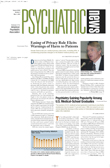Until September 11, many New Jersey psychiatrists practiced in the shadow of the World Trade Center just across the Hudson River. Now they live and treat their patients in the shadow of future terrorist attacks. As a result, they have been compelled to deal with the psychological effects of terrorism to an extent they never imagined.
To enhance psychiatrists’ knowledge of disaster-related mental health issues—as well as that of their colleagues throughout the state—the New Jersey Psychiatric Association (NJPA) devoted its annual spring meeting in April to the challenges psychiatrists and other physicians face as they prepare for the possibility that they will be called on to respond to future acts of terrorism.
Joseph Napoli, M.D., one of the speakers at the meeting and chair of the NJPA’s Disaster Preparedness Committee, was involved in the psychiatric response to the World Trade Center attacks. He emphasized that psychiatrists have a tripartite role to play in the aftermath of terrorist acts, since their skills are needed in three critical areas—outreach services, local hospital emergency departments, and their private offices—immediately after a terrorist attack or other traumatic event.
He cautioned against assuming trauma-induced stress is a “normative response to the horror of terrorist acts,” and thus people who exhibit its symptoms do not require psychiatric or other acute mental health interventions. Whether people are suffering from an acute stress disorder or from PTSD, psychiatrists need to provide diagnostic and treatment services as soon as possible, Napoli suggested. It is critical for psychiatrists to “distinguish normal grief reactions from major depression,” he said, since the cost of an untreated major depression could be suicide.
With chemical terrorism now a very real threat, psychiatrists and other physicians must also be on alert that psychiatric symptoms after such an attack “are due to a chemical substance and perhaps are not a manifestation of acute stress disorder.”
In contrast, Napoli pointed out, acute anxiety may be a direct result of people’s belief that they were contaminated by a chemical or biological attack, when that is not the case.
He said it is critical that hospitals prepare for terrorist attacks “by formulating disaster plans so that they are ‘part of the solution and not part of the problem.’ ” Psychiatrists and mental health professionals have a duty to ensure that such plans include setting up areas for patient counseling, a family reception and counseling center, and a media center in which press conferences can be held, Napoli said. He added that provisions should also be in place to respond to the mental health needs of hospital personnel.
Napoli recommended to the psychiatrists that their hospitals hold disaster drills and update their disaster-response plans twice a year.
Napoli heads the Crisis Response Team of the Fort Lee Office of Emergency Management. (Fort Lee is the town on the New Jersey end of the George Washington Bridge.) In this capacity he directed a group of mental health professionals and clergy who provided trauma-related counseling services to employees of the Port Authority of New York and New Jersey after the loss of more than 200 of their colleagues in the collapse of World Trade Center, as well as to victims’ families.
“With the FDA approval of sertraline and paroxetine for PTSD, we have advanced tremendously in the office-based psychopharmacological treatment of this disorder,” he stated. “Nevertheless, early intervention and secondary prevention are the ‘hot areas’ in PTSD research, especially in regard to disaster psychiatry. Unfortunately, at this stage of our knowledge, we have scant data to answer such questions as, Who should be treated? How can we detect who is at risk? When should they be treated? What should we use to treat them?”
Col. Ann Norwood, associate chair of the psychiatry department at the Uniformed Services University of the Health Sciences and chair of the APA Committee on Psychiatric Dimensions of Disaster, alerted the audience to the different types of stress and plans that need to be in place to address the range of responses to trauma and terrorism, from normal to serious.
Norwood described the differences between acute traumatic stress symptoms, which could be considered a “normal” response to life-threatening events, and the long-term psychiatric consequences of PTSD. Referring to last fall’s anthrax attacks and the panic that ensued, Norwood emphasized that with other terrorist attacks still possible in the United States, physicians and other health care decision makers must have in place special laboratory testing facilities and personnel trained to use them. They also need to ensure that experts are available to talk to the media and general public about the unfolding events and what they do, and do not, need to be concerned about.
There is an urgent need for emergency medical personnel to develop strategies for disaster response, including triaging and treating victims, said Marc Borenstein, M.D., chair and residency training director of the department of emergency medicine at Beth Israel Medical Center in Newark, N.J. These plans, he noted, must be designed to address natural disasters, as well as terrorist attacks, including biological and chemical ones.
Psychiatrist Jerrold Post, M.D., also addressed the meeting. Post, a professor of psychiatry, political psychology, and international affairs at George Washington University, offered an overview of state-sponsored and individual terrorism throughout the world, particularly in the wake of the events of September 11. He portrayed these acts as “a battle for hearts and minds” waged by disenfranchised people who view themselves as disrespected, have no hope for a better life, and find meaning only in acts of revenge.
He cautioned that military responses aimed at the people who direct and carry out terrorism are futile and will just end up triggering a cycle of ever-escalating terrorism and military actions. ▪
